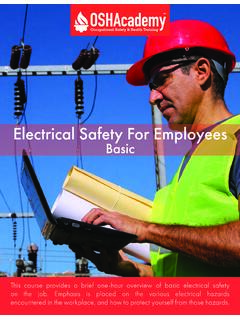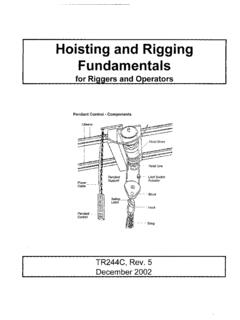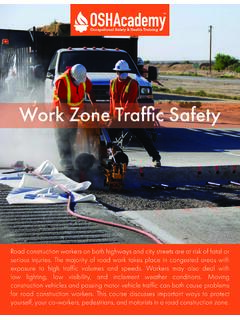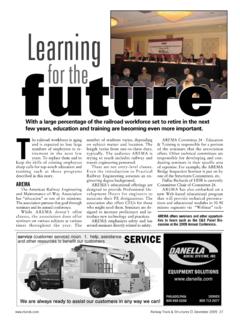Transcription of 603 Stairway and Ladder Safety - OSHA Training
1 Stairways and ladders are a major source of injuries and fatalities among workers. OSHA estimates there are as many as 36 fatalities per year due to falls from stairways and ladders used in construction. This course is designed to provide both employers and employees with the knowledge needed to work safely on stairways and and Ladder Safety This page intentionally blank OSHA cademy Course 603 Study Guide Stairway and Ladder Safety Copyright 2021 Geigle Safety Group, Inc. No portion of this text may be reprinted for other than personal use. Any commercial use of this document is strictly forbidden.
2 Contact OSHA cademy to arrange for use as a Training document. This study guide is designed to be reviewed off-line as a tool for preparation to successfully complete OSHA cademy Course 603. Read each module, answer the quiz questions, and submit the quiz questions online through the course webpage. You can print the post-quiz response screen which will contain the correct answers to the questions. The final exam will consist of questions developed from the course content and module quizzes. We hope you enjoy the course and if you have any questions, feel free to email or call: OSHA cademy 15220 NW Greenbrier Parkway, Suite 230 Beaverton, Oregon 97006 + Disclaimer This document does not constitute legal advice.
3 Consult with your own company counsel for advice on compliance with all applicable state and federal regulations. Neither Geigle Safety Group, Inc., nor any of its employees, subcontractors, consultants, committees, or other assignees make any warranty or representation, either express or implied, with respect to the accuracy, completeness, or usefulness of the information contained herein, or assume any liability or responsibility for any use, or the results of such use, of any information or process disclosed in this publication. GEIGLE Safety GROUP, INC., DISCLAIMS ALL OTHER WARRANTIES EXPRESS OR IMPLIED INCLUDING, WITHOUT LIMITATION, ANY WARRANTIES OF MERCHANTABILITY OR FITNESS FOR A PARTICULAR PURPOSE.
4 Taking actions suggested in this document does not guarantee that an employer, employee, operator or contractor will be in compliance with applicable regulations. Ultimately every company is responsible for determining the applicability of the information in this document to its own operations. Each employer s Safety management system will be different. Mapping Safety and environmental management policies, procedures, or operations using this document does not guarantee compliance regulatory requirements. Revised: May 14, 2021 This page intentionally blank Course 603 Contents Course Introduction.
5 1 Module 1: Types of Ladders .. 2 Introduction .. 2 Ladder 2 Necessary Questions .. 3 Portable Ladders .. 3 Extension Ladders .. 4 Folding and Platform Ladders .. 5 Straight or Single Ladders .. 6 Articulated Ladders .. 6 Double-Cleated Ladders .. 7 Tripod Ladders .. 7 Extension Trestle Ladders .. 8 Job-Made Ladders .. 8 Module 2: General Requirements Ladders .. 10 Introduction .. 10 Securing Ladders .. 11 Inspecting Ladders .. 11 Real Life Scenario .. 12 Three-Point-Control vs. Three-Point-Contact .. 13 Three-Point-Contact .. 13 Three-Point-Control .. 14 Ladder Angle .. 15 Course 603 Real Life Scenario.
6 16 Module 3: General Requirements Stairways .. 18 Introduction .. 18 Stairways Used During Construction .. 18 Temporary Stairways Used During Construction .. 19 Stair Rail 19 Handrail Requirements .. 20 Mid Rail Requirements .. 21 Stairs and 3-Point Control .. 22 Glossary .. 23 Course 603 Copyright 2017 Geigle Safety Group, Inc. Page 1 of 23 Course Introduction Stairways and ladders are a major source of injuries and fatalities among workers. According to the Bureau of Labor and Statistics (2012), 14 percent of all work-related deaths are due to falls, with 20 percent of these deaths being related to the use of ladders.
7 The Occupational Safety and Health Administration (OSHA) estimates there are more than 24,000 injuries and as many as 36 fatalities per year due to falls from stairways and ladders used in construction. Nearly half of these fall-related injuries are serious enough to require time off the job. These statistics are a sobering reminder of the dangers faced when working on or around ladders and stairways. More importantly, most, if not all, of these injuries and deaths could have been prevented. This course is designed to provide both employers and employees with the knowledge needed to work safely on stairways and ladders.
8 Course 603 Copyright 2017 Geigle Safety Group, Inc. Page 2 of 23 Module 1: Types of Ladders Introduction Ladders are often the first tool we choose when working at an elevation. This may explain why more workers are injured in falls from ladders than from any other elevated surface - roofs, scaffolds, balconies, even stairs. Why do workers fall from ladders? Most falls happen because workers select the wrong type of Ladder for their job, or they set up the Ladder improperly and the Ladder shifts or slips unexpectedly. Workers also fall when they're not working safely on the Ladder - their foot slips, they lose their balance, they overreach, or something knocks the Ladder over.
9 Ladder Selection Be sure the Ladder being used has the proper duty rating to carry the combined weight of the user and the material being installed. A Ladder 's duty rating tells you its maximum weight capacity. There are five type classifications with associated duty ratings: Type IAA - These are special duty ladders. Type IAA ladders are for extra-heavy-duty professional use only. Type IA - These ladders have a duty rating of 300 pounds. Type IA ladders are recommended for extra-heavy-duty industrial use. Type I - These ladders have a duty rating of 250 pounds. Type I ladders are manufactured for heavy-duty use.
10 Type II - These ladders have a duty rating of 225 pounds. Type II ladders are approved for medium-duty use. Type III - These ladders have a duty rating of 200 pounds. Type III ladders are rated for light-duty use. Check out this short audio clip by Dan Clark of the Here Dan reviews the two types of ladders, freestanding and self-supporting, and how employees can be safe using each. Quiz Instructions After each section, there is a quiz question. Make sure to read the material in each section to discover the correct answer to these questions. Circle the correct answer. When you are Course 603 Copyright 2017 Geigle Safety Group, Inc.



















